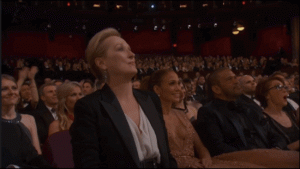Every year, billions of people around the world cozy up in front of their TVs to watch rich people receive a gold award shaped like a man for their achievements in acting like other people. At its core, that’s what the Academy Awards is. So, what makes it so compelling?
The famous people are part of it, as is the glitz and glamour that has surrounded the night for nearly 90 years. But my personal view is that the night gathers so much attention because of the story being told. From the red carpet and the behind-the-scenes shots, to the speeches and the post-awards interviews, the media (with the help of social media) loves crafting stories around what is essentially a gathering of otherwise boring, rich people.
From a marketing point of view, there are dozens of lessons to be learned – but more specifically, there are a few strong points to be made about how we use, create and share content.
So without further ado, those lessons are… (drum roll please)…
- The right message spreads a long way
True content marketers understand the importance of unique content, but sometimes it’s less about an exclusive message and more about it being timed just right.
This year, the two speeches with the most buzz were by Patricia Arquette and Graham Moore, who called for wage equality and raised awareness about depression respectively, garnering hollers from the crowd (mainly Meryl Streep, let’s be honest.)
Why were the speeches so good? Because they were authentic. You can tell Arquette truly cares about the issue of wage equality, while Moore drew on his own experience with depression and nearly taking his own life to get his message across about being true to yourself.
People everywhere can see right through the “I wish for world peace!” message, but will stand up and take note when your content and its message is genuine and heartfelt.
- Content isn’t just about words, it’s visual
What gets the most attention at the Oscars? Is it the movies? The speeches? The musical performances? Nope. Rightly or wrongly, it’s the pre-show red carpet, where people ogle and judge celebrities in their designer garb, snapping photos and posting images to social media and blogs all over the world.
Incorporating visual elements into your content marketing strategy is crucial. Humans are visual beings, so think about where you can include pictures and infographics into your articles and overall strategy.
- When content is unexpected, it works even better
Constantly pumping out content (correction: good content) is necessary to gain traction in any campaign, but sometimes it’s good to shock people. Lady Gaga used to shock the masses by wearing dresses made of meat, but at the Oscars she shocked by, well, just singing.
After dropping off the radar for months, Gaga appeared as if from nowhere to sing an incredible tribute to The Sound of Music and its star, Julie Andrews, and floored everyone. Her performance was a far cry from the Gaga we know, and she got a standing ovation for her stellar efforts.
The lesson here? Surprise people! Create content your audience won’t expect – you have a platform to create anything you want, so go Gaga with it.
- Storytelling matters
Okay, so I know I’m supposed to be talking about this year’s Oscars, but the 2012 awards presented such a fantastic example of storytelling that it can’t be ignored. It was the year The Artist, a completely silent movie, took home Best Picture. It was the first time in 83 years that a silent motion picture scooped the big award. It was (and still is) a big deal and an incredible example of the importance of storytelling.
The movie stood out not just because of the acting, but because of the love story. With content, we are lucky we can use words to tell a story – but it’s all about how you craft the narrative, report, press release, blog or information you’re trying to use to engage your audience. Tell a story people can identify with!
- Know what your audience wants
The hashtag that is still trending since the Oscars is #AskHerMore – a call to action for red carpet correspondents to ask female celebrities more compelling questions than “who are you wearing?” The trend was started by the Representation Project and is supported by Smart Girls (an organisation headed by Amy Poehler), and it gained massive traction on Twitter in the lead up to the show to ask about the work, not the dresses.
When your audience is asking for something, it’s your job to give them the information they need. Know what they want and cater to it in a creative way.
(P.s. E!’s ‘Mani Cam’ – a camera that focuses on what the stars’ manicured nails look like – was axed for this year’s awards after the #AskHerMore campaign highlighted its absurdity.)
- In the end, good content always wins
JULIANNE MOORE FINALLY WON AN OSCAR. Yep, after four previous Academy Award disappointments, Moore finally took home a golden statue for her portrayal of a linguistics professor with early-onset Alzheimer’s in Still Alice.
Although Moore has won countless Golden Globes and other awards in her late-blooming career, she’s held out for the Oscar and finally got it (YAY!) proving that sometimes an entire body of works speaks louder than a one-hit wonder.
With content, your results aren’t going to show overnight – and that’s okay. What’s important is that the entire campaign and strategy is strong, consistent and carefully managed to ensure you get what you need out of it.
Get in touch with us at [email protected] if you’re interested in creating compelling, meaningful and targeted content for your business.
138624_0188 image by Disney | ABC Television Group is licensed under CC BY 2.0.







